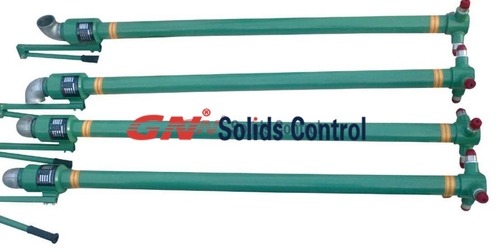Solids control service providers all over the world are common use the rectangular drilling fluid circulating tank for the reason that installation and migration performance of the system is very effective. At the same time, it doesn’t matter how good the mud agitator perform in excellent situation, the drilling fluid tank have the ability to corners that mud agitator’s propellers cannot reach and stir. In an effort to resolve this condition, install the mud gun in the top of the tank to agitate the far corner of the mud tank.
Mud gun functions as supportive machinery to the mud agitator. It comes along with nozzle that either made fixed angle or 360 degree ration angles the positive spray-effect distance of mug gun is approx. 3 meters long. The gun size is involved with drilling fluid density, viscosity and nozzle spray speed. Mud gun is mounted the top of the mud tank can be need adjusted as need whenever you want. The mud gun is connected with a motor-pump to stir the drilling mud and stop the solids from sinking on the base of the mud tank. The mud is mixed by being suck- withdraw into a pipe by a powerful pump and inject back into the mud tank by being pressured carry on the nozzle of the mud gun. The procedure is almost like how a jet sprays in the dish washer disposal.
Drilling mud is a wet mud like substance resembles like thick clay and is accustomed to retain the drill head in controlled-temperature and bear there mains of drilling cutting to the surface in water and oil and gas drilling operations. The mud is recycled and reused by passing it through several steps of filter and cleaning by screens of the shale shaker or mud cleaner and decanter centrifuge as it is circulated into the mud tanks then returning to the drill well on the drilling rig. So as to keep the mud as liquid-liked as they possibly can, a mud gun and mud agitator is utilized to keep the tank agitated and mixed. Drilling mud is made by mixing water and oil with a clay-like substance and also other chemicals.
